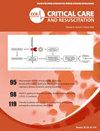重新定义血管舒张性休克的血管加压治疗的现代范例
IF 1.7
4区 医学
Q3 CRITICAL CARE MEDICINE
引用次数: 0
摘要
血管扩张性休克仍然是重症监护病房发病率和死亡率的主要原因。血管加压药是治疗血管扩张性休克的基础,尽管进行了充分的液体复苏,但其对器官特异性血流、灌注和氧合的影响是复杂的,可能导致伤害。这篇综述总结了里纳尔多·贝洛莫教授在临床实践中推进血管加压疗法知识的广泛贡献。他工作的核心是个性化血流动力学目标的概念,通过“平均灌注压缺陷”的概念引入,将病前灌注压与结果联系起来,并挑战了平均动脉压阈值≥65 mmHg的普遍应用。与Clive May教授合作,Bellomo建立了一个长期仪器化的高动力脓毒症大型动物模型,对大循环和微循环之间的不协调、肾髓质对缺氧的脆弱性以及脓毒性急性肾损伤的机制产生了基本的见解。该模型可以直接比较健康动物和感染性休克时血管加压药物的差异,证明它们对整体和局部血流、灌注和组织氧合的异质性影响。通过关键的临床试验,从早期研究反驳“肾剂量多巴胺”的效用,到对ATHOS(血管紧张素II治疗高输出休克)项目的里程碑式贡献,将知识转化为床边,ATHOS(血管紧张素II治疗高输出休克)项目确立了血管紧张素II作为难治性血管扩张性休克的新型血管加压剂。总的来说,Bellomo的工作已经将血管加压疗法从经验惯例转变为个体化实践,并继续为临床研究和指南制定提供信息。本文章由计算机程序翻译,如有差异,请以英文原文为准。
Redefining the modern paradigm of vasopressor therapy for vasodilatory shock
Vasodilatory shock remains a leading cause of morbidity and mortality in the intensive care unit. Vasopressors are the cornerstone of treatment when vasodilatory shock persists despite adequate fluid resuscitation, yet their effects on organ-specific blood flow, perfusion, and oxygenation are complex and may contribute to harm. This review summarises the extensive contributions of Professor Rinaldo Bellomo to advancing our knowledge of vasopressor therapy in clinical practice. Central to his work was the concept of personalised haemodynamic targets, introduced through the concept of “mean perfusion pressure deficit”, which linked premorbid perfusion pressure to outcomes and challenged the universal application of a mean arterial pressure threshold of ≥65 mmHg. In collaboration with Professor Clive May, Bellomo established a chronically instrumented large animal model of hyperdynamic sepsis, yielding fundamental insights into the discordance between the macrocirculation and microcirculation, the vulnerability of the renal medulla to hypoxia, and the mechanisms of septic acute kidney injury. This model enabled direct comparison of vasopressor drugs in both healthy animals and during septic shock, demonstrating their heterogeneous effects on global and regional blood flow, perfusion, and tissue oxygenation. Knowledge translation to the bedside was achieved through the conduct of pivotal clinical trials, from early studies refuting the utility of “renal-dose dopamine” to landmark contributions to the ATHOS (angiotensin II treatment of high-ouput shock) program, which established angiotensin II as a novel vasopressor in refractory vasodilatory shock. Collectively, Bellomo’s work has transformed vasopressor therapy from empirical convention towards individualised practice, and it continues to inform clinical investigation and guideline development.
求助全文
通过发布文献求助,成功后即可免费获取论文全文。
去求助
来源期刊

Critical Care and Resuscitation
CRITICAL CARE MEDICINE-
CiteScore
7.70
自引率
3.40%
发文量
44
审稿时长
>12 weeks
期刊介绍:
ritical Care and Resuscitation (CC&R) is the official scientific journal of the College of Intensive Care Medicine (CICM). The Journal is a quarterly publication (ISSN 1441-2772) with original articles of scientific and clinical interest in the specialities of Critical Care, Intensive Care, Anaesthesia, Emergency Medicine and related disciplines.
The Journal is received by all Fellows and trainees, along with an increasing number of subscribers from around the world.
The CC&R Journal currently has an impact factor of 3.3, placing it in 8th position in world critical care journals and in first position in the world outside the USA and Europe.
 求助内容:
求助内容: 应助结果提醒方式:
应助结果提醒方式:


